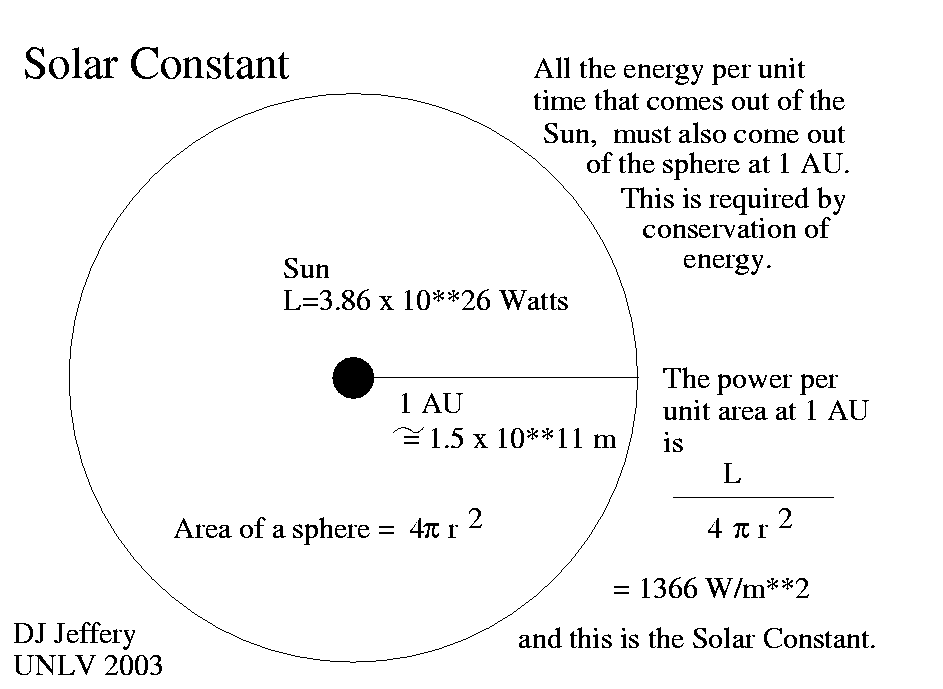
Caption: The solar constant illustrated.
Features:
- The solar constant
is the integrated
radiant flux (AKA flux)
(power per unit perpendicular-to-the-beam area per unit time)
from the Sun
at the mean
Earth-Sun distance
(i.e., the
astronomical unit (AU) = 1.49597870700*10**11 m)
from the Sun.
- The value just calculated is a fiducial value
But the solar constant is NOT exactly constant due to variations in the solar luminosity.
The mean solar constant = 1367.6 W/m**2 (see NASA: Earth fact sheet).
- A fiducial value
for the solar constant can be calculated
using the inverse-square law
for istropic radiation:
i.e.,
electromagnetic radiation (EMR)
from an istropic source which in this case
is the Sun:
The fiducial value solar constant = L/(4π r**2)
= (3.828*10**26 W)/(4π*(1.49597870700*10**11)**2] = 1361.2 W/m**2
which is NOT quite the best measured value which is mean solar constant = 1367.6 W/m**2 (see NASA: Earth fact sheet) and where we have used solar luminosity L_☉ = 3.828*10**26 W, the astronomical unit (AU) = 1.49597870700*10**11 m, and the units are watts (i.e., joules per second) per meter squared.
- The solar constant
has a periodic-on-average variation of ∼ 0.05 %
that is correlated with the
solar cycle.
- There is also a long-term
secular increase
that is too slow to measure, but that is predicted by
computer simulations.
Circa 4 Gyr ago, the Sun was ∼ 30 % less bright than today and circa 4 Gyr in the future, it will be ∼ 40 % brighter than today (see sun_evolution.html).
This prediction is as certain as theory can be.
Alas, the long-term increase spells the doom of complex life on Earth and then later all life on Earth (see Wikipedia: Future of Earth: Climate Impact; Rampino, M. R. & Caldiera, K. 1994, ARAA, 32, 83-114, The Goldilocks Problem: Climatic Evolution and Long-Term Habitability of Terrestrial Planets).
- The actual integrated
radiant flux (AKA flux) from the
Sun at the top of the
Earth's atmosphere
has a periodic variation over the course of year
due to the
Earth's orbital eccentricity
ε = 0.0167086 (J2000)
The range of variation is ∼ 6.7% from a low of ∼ 1321 W/m**2 at aphelion circa Jul05 when Earth is farthest from the Sun to a high of ∼ 1412 W/m**2 at perihelion circa Jan03 when Earth is closest to the Sun (see Wikipedia Solar Constant; Wikipedia: Earth's orbit: Events in the orbit).
This solar power variation must have some effect on the Earth's climate, but it is much less than the effect of the Earth's axial tilt which is the main driver of the seasons.
- The solar constant
is a vital parameter
for the biosphere:
for life on Earth.
It is a key number for the Sun-supplied energy that we need to keep warm and for photosynthesis in plants which is the origin of almost all the chemical energy used by biota.
- Why is the solar constant
so nearly constant?
Nearly the same question is why is the
Sun so quiescent
(i.e., inactive)?
The anthropic principle answer is because we are here.
If the solar constant varied tremendously---which a contradiction in terms---life as we know it would NOT exist on Earth.
Speaking generally, the anthropic principle tells us the observable universe must evolve a significant number of quiescent stars to allow much chance for life as we know it.
Image link: Itself.
Local file: local link: solar_constant.html.html.
File: Earth file: solar_constant.html.